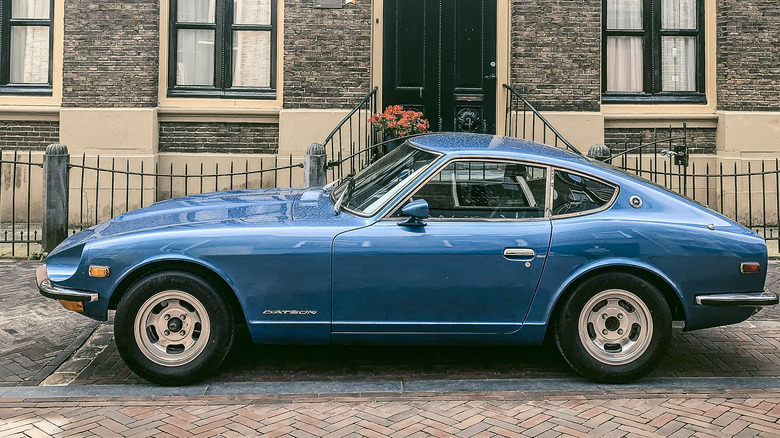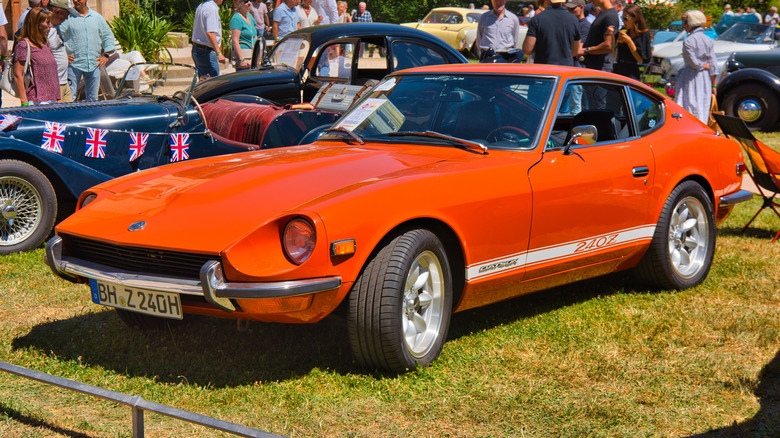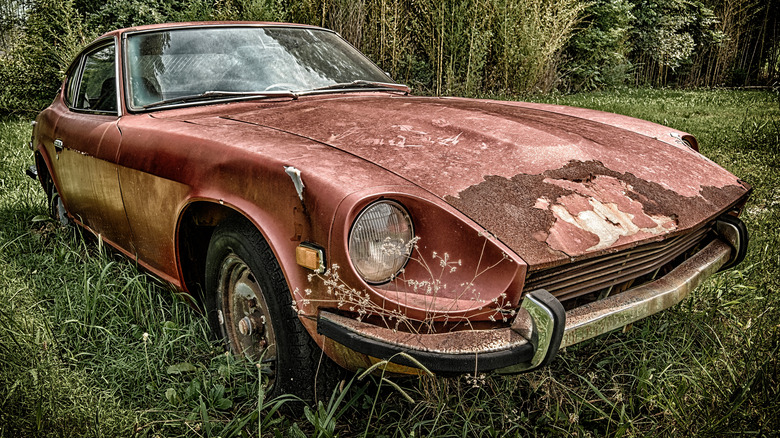Why The 1970 Datsun 240z Was Way Cooler Than You Remember
Classic cars are a bit like a bag of onions. Each onion is an era, like the golden age of muscle cars, or that period of the 1960s when European sports coupes were all the rage, or the "Miami Vice" era when muscle made way for high-performance sports cars. The outer layer of that onion is always the obvious choice. There's the Ford Mustang, or the Porsche 911, or the Ferrari Testarossa. In a way, that outer layer is a bit boring, bland, and inedible. When you peel it off and discard it, you'll be able to spot the more interesting flavorsome layers. A Ferrari 250 GTO, a Plymouth Barracuda, or an Audi Quattro. If you find an onion marked 1970, one of those deep layers will be the Datsun 240z.
Datsun was the export name for Nissan until 1981, and the 240z was sold as the Nissan Fairlady Z in certain markets. The Z designation has long been how Nissan marked its sports models, though it doesn't like hearing the 240z referred to as a sports car. Instead, it's a "personal GT." The 240z also had a decent legacy, spawning variations like the 260z and 280z (the latter of which was once both owned and totaled by Guy Fieri) — they featured 2.6 and 2.8-liter engines, respectively.
There was also an attempt to relaunch its Z car line in the late 1990s by buying and restoring classic 240zs before passing them on to dealerships. There's an argument that the foundation for legendary motors like the Nissan Skyline was laid in the 1970s with the original Z line. But why focus on legacy when the original example is so brilliant?
The Datsun 240z incorporates everything good about a great motoring era
If you're looking for a unique example of what was great about 1970s motoring, then the Datsun 240z is a fantastic place to start. Powering the vehicle is a six-cylinder, 2.4-liter single-overhead-cam engine which maxed out at 151 horsepower. This is roughly the same horsepower you would get from a basic 1970s Ford Mustang, despite the Ford having a far larger engine. If you look beyond the superiority of Japanese engineers when compared to their 1970s American counterparts, you'll find plenty of other areas where the 240z stands out as an absolute gem.
In terms of styling, it has that classic coupe shape that still endears people to late 1960s/early 1970s automobiles. The grille is flat, but the parts around it add an aggressive shape to the vehicle's front. The bonnet is obscenely long, the windscreen is large, and the roof slopes back smoothly in the fastback style. Look closer, and you'll see why the Datsun 240z is truly special.
In a way, it's as if someone blended the DNA of that era's most iconic vehicles and used the resulting sludge to develop what is arguably the best car of 1970. Look closely and you'll see little bits of Porsche 911 in the headlights, elements of Corvette in the overall shape, touches of Chevy Camaro where things get a little pointy. A little E-Type in the bonnet. Nissan copied everyone's homework and subsequently aced the test.
If you want one, the prices vary
Some examples of the Datsun 240z survive to this day, and you can pick one up pretty easily on the second-hand market. If your budget is between $2,000 and $5,000, you're going to need to put some serious work in. The examples you'll find won't be running, and in some cases won't have been used for a long time — so a complete engine rebuild is likely in order. Things aren't much better when it comes to comfort and aesthetics. At this price point, you can expect tattered paint, severe panel rust, and an interior that was likely past its prime 45 years ago. As it's a far rarer car than something like a Mustang from that era, parts are also going to be harder to find and more expensive to acquire.
If a project car isn't for you, then expect to take a hard hit in the savings account. A pristine example of the Datsun 240z can cost somewhere in the region of $70,000 — which is well into Jaguar E-Type territory. Some particularly rare examples have even commanded six-figure price tags. The middle ground may be your best bet, as you can acquire something in working order that's just in need of a little TLC for $20,000 to $30,000. Unless you're very comfortable with bodywork, you should swerve anything with deep rust — especially if you're paying five figures for your classic.


